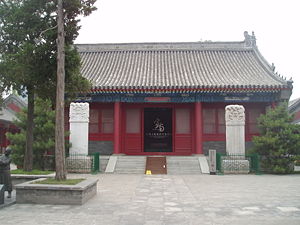
Changchun Temple
Encyclopedia

Buddhist temple in the Xuanwu District of Beijing
Beijing
Beijing , also known as Peking , is the capital of the People's Republic of China and one of the most populous cities in the world, with a population of 19,612,368 as of 2010. The city is the country's political, cultural, and educational center, and home to the headquarters for most of China's...
, China
China
Chinese civilization may refer to:* China for more general discussion of the country.* Chinese culture* Greater China, the transnational community of ethnic Chinese.* History of China* Sinosphere, the area historically affected by Chinese culture...
. The temple also houses the Xuanwu Cultural Museum.
History
The temple was first built by the WanliWanli
Wanli may refer to:* Wanli Emperor , Chinese emperor of the Ming Dynasty* Wanli District , district of Nanchang, Jiangxi, People's Republic of China* Wanli District, New Taipei , a district in New Taipei City, Republic of China...
emperor's mother during the Ming Dynasty
Ming Dynasty
The Ming Dynasty, also Empire of the Great Ming, was the ruling dynasty of China from 1368 to 1644, following the collapse of the Mongol-led Yuan Dynasty. The Ming, "one of the greatest eras of orderly government and social stability in human history", was the last dynasty in China ruled by ethnic...
in 1592. in 1679, the temple was heavily damaged in an earthquake, and was never really restored to its former glory, and later became a storage space for coffins. Following the establishment of the People's Republic in 1949, the temple was transformed into housing. In 2001, the temple was put under cultural protection and went through an extensive renovation costing nearly 200 million RMB. In 2005 the temple reopened as the Xuanwu cultural museum.

